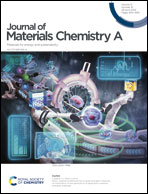Exchanging interlayer anions in NiFe-LDHs nanosphere enables superior battery-type storage for high-rate aqueous hybrid supercapacitors†
Abstract
Owing to the remarkable adjustability of layers, layered double hydroxides (LDHs) can adopt superior conductivity and a charge-storage capacity. However, controlled tuning of layers spacing in LDHs is a major challenge, and they can suffer from stacking issues, structural degradation, and issues with interstitial ion insertion. Herein an effective strategy of exchanging interlayer ions within laminates was efficiently realized. Despite the layered spatial structure and morphological perturbation, the exchange of carbonate ions (CO32−) by sulfate anions (SO42−) into the interlayers of the NiFe-LDHs nanostructure revealed an expansion of the layer spacing and rapid ion intercalation. A three-fold enhancement of the specific capacitance in NiFe-LDHs with sulfate anions (NFS), i.e. 527 F g−1, was achieved over NiFe-LDHs with carbonate anions (NFC), i.e., 171 F g−1, at 0.5 A g−1 in 6 M KOH aqueous electrolyte. Further, the aqueous hybrid supercapacitor (AQHS) of NFS-LDHs nanoplates displayed a high specific capacitance of 30 F g−1 at 0.5 A g−1, with a high energy density of 11 W h kg−1 and a power density of 5500 W kg−1. It eventually exhibited a tremendous capacitance retention of 83% at 3 A g−1 with a coulombic efficiency of 82% at up to 10 000 cycles. Thus the expansion of the layer spacing resulted in enhanced ionic intercalation, and improved conductivity and redox activity, underscoring the potential of NFS-based LDHs for advancing the performance of aqueous hybrid supercapacitors.

- This article is part of the themed collection: 2024 Journal of Materials Chemistry A HOT Papers


 Please wait while we load your content...
Please wait while we load your content...